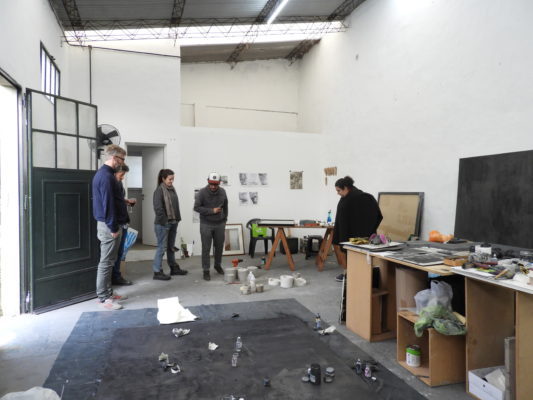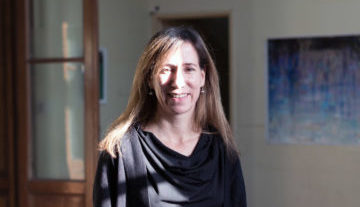Search
To search for an exact match, type the word or phrase you want in quotation marks.
A*DESK has been offering since 2002 contents about criticism and contemporary art. A*DESK has become consolidated thanks to all those who have believed in the project, all those who have followed us, debating, participating and collaborating. Many people have collaborated with A*DESK, and continue to do so. Their efforts, knowledge and belief in the project are what make it grow internationally. At A*DESK we have also generated work for over one hundred professionals in culture, from small collaborations with reviews and classes, to more prolonged and intense collaborations.
At A*DESK we believe in the need for free and universal access to culture and knowledge. We want to carry on being independent, remaining open to more ideas and opinions. If you believe in A*DESK, we need your backing to be able to continue. You can now participate in the project by supporting it. You can choose how much you want to contribute to the project.
You can decide how much you want to bring to the project.

Amateur. Lover of. Its first definition refers to aficionado, but if we examine its etymology in greater depth we’ll see that the term comes from the French, as amateur replaces the word amativederived in turn from the Latin word amãtor, meaning lover of.[i] More recently, in this shift from the first amatory condition to the second of aficionado, the word amateur begins to be associated with liking and with showing an interest in an object or activity (usually related to sports) that is performed without receiving any money in exchange, i.e., a disinterested interest in accomplishing. Loving then becomes liking for the sake of liking, accomplishing for the pleasure of it, creating for the sake of creating, which could be a useful detail for rethinking the concept of amateurism in the present and its relationship with art and artists’ residencies.
In terms of artistic production, we could conceive artists as creative beings set in their own time and place whose creativity is associated with a craft that has developed over time according to their accomplishments and ideas, shaping a profession that would ideally be communicated without great conditioning or speculation. In this case, art would undoubtedly be an accomplishment linked to a conscientious action from personal experience that is original and at once shared with others as it necessarily forms a part of their time. This could already be a distant ideal, given that today the word professionalisation appears much more frequently, along with terms like optimisation and efficiency in relation to the market and the strategic, speculative world.
As this concept of the amateur that is at once linked to practice but is also forgotten or silent, it wouldn’t be a bad idea to explore the place and the role of an artists’ residency as a model that emphasises making art in a place shared with other people. A place where what is common is (everyone’s) nature as producers of art, a characteristic shared with the visiting public, as artists in residency are still producers rather than exhibitors, works are processes rather than end products, and visiting audiences are direct witnesses of the work of the artists in their presence.
This kind of associative workplace we call artists’ residencies may encourage the idea of amateurism (as regards the pleasure of making) or at least prompt our return to the kind of amateurism that isn’t that common or isn’t really taken into account. Given that these are spaces that support openness, freedom and experimentation, they are able to usher in the new, which is always a necessary phase (despite being initially formless) that connects artists with more intuitive, archaic work closer to nature and to personal experience, to a making in which they continue to discover and arrive at truth, at the origin.[ii]
In artists’ residencies, almost everything occurs in a space where people chat as they look at what others are making in the knowledge that others are doing the same; a space that inspires shared work, work made with others or alongside others. Work connected to speaking and saying, because it triggers conversations that assemble all the art generated in these spaces. The art produced in residency emphasises experimentation, trial over skill; mistakes are valued and doubting is good. Everything is possible because there are no exams or qualifications, no slogans or blueprints to follow. No final deadlines or formal exhibition events, just a shared meeting with audiences. An open-day mediation meeting where artists talk to visitors and where the works produced mediate in the conversations.
This idea of involvement between observer and artwork triggered the concept of open studios,[iii] i.e., specific events organised at artists’ residencies when doors are opened for the public to enter and visit the workshops, not only to see the different stages of production but also, and more importantly, to do so in company of the artists. Artists’ residencies imply working beside other artists but also sharing their making and making time to show the projects, chatting about the work in the very space of its production shortly after it has been produced or when it is still in production. Somehow the artwork is still being created when it is contemplated and shared with those who happen to be there at the time, favouring a closer approximation between observer and producer.
For all these reasons, once again we may associate amateurism with the same operative mode of artists’ residencies and with other open projects that have different ways of relating to knowledge and creation.[iv] And perhaps because artists usually travel lightly to these residencies where the work elements and tools they find are very basic, they are able to connect more directly with their artistic origins, with the landscape the world had to offer them and without any previous knowledge return to a foundational place, a place of initiation, renewing and reviving the first impulse that steered them towards art before they had learnt the ropes.
Perhaps it is this romantic angle that persuades me to look for these amatory situations in the making of things. Any things. Existential. A place where art is an idea and an accomplishment that unites us to our specie and leads us, as human beings, to a deeper ontological space. If this isn’t evoked or conveyed by the artwork, perhaps it wasn’t the result of a need for accomplishment. Before writing this essay I thought back to other texts that I consider fundamental. Letters to a Young Poetby Rilke[v] for instance, that describes a making linked to the heart, and above all an inability to stop making (in this case, writing); making as an unstoppable or ungovernable need. Or Benjamin’s The Author as Producer,[vi] that also prioritises the creative work of artists or writers, particularly their connection with their context and the present, the importance of their relations with others, with the techniques and work tools of their age, with the processes of artistic production, generating artworks that audiences approach from the position of producers, not only observers. Not that audiences are more active, only perhaps more complete or different.
So, to return to the idea of amateurism in the first instance, directly related to the notion of love that besides being social is, above all, intuitive and spontaneous, we could consider it prior, parallel or at least complementary to what we call a professional career, formal training and professionalisation. Amateurism as a natural condition, with no established, overlearnt or excessively formatted or stigmatised considerations. Perhaps the phrase ‘art for art’s sake’ (from the French l’art pour l’art) derives from this principle that precedes doctrines, norms, programmatic knowledge and the very tradition it describes in terms of canons and labels.
I still believe that artists’ residencies offer artists the possibility of relating to an idea of originality linked to their singularity as producers who participate in a genuine exercise of authorship, in a shared sphere of learning and making, defending the unique quality of the art object regardless of its price and the features that distinguish it from other forms of work. A unique existence in the world, explained by its maker, not just as material of a given shape or colour but with a soul of its own. I often approach artists’ works from an animistic position; I try to discover their soul, their heart, or a pulse that the artist could have left in their material. It is decidedly an animistic idea I have of works that interest and move me, because I believe they have been given a soul and because, metaphorically, poetically or idealistically speaking, they connect me to the individual that produced them. Because I believe that professional artists who work with their souls are also able to create something that has a soul of it
[i] Definitions taken from several dictionaries, including the Shorter Oxford English Dictionary and https://en.wikipedia.org/wiki/Amateur
[ii] We could mention here the notion of Aletheiaand Heidegger’ essay ‘The Origin of the Work of Art’. See Martin Heidegger, Basic Writings, ‘The Origin of the Work of Art’, David Farrell Krell (ed.), 1st Harper Perennial Modern Thought Edition, HarperCollins, New York, 2008, pp. 143-212.
[iii] Besides open studios, audiovisual presentations are also often held at which artists chat with audiences about their projects, present and future, usually at the beginning of residencies.
[iv] Not to mention that today, the term amateur is erroneously used in a negative sense to refer to that which is not professional or is lacking in seriousness and commitment. This could explain why some artists’ residencies are thought to encourage excessive freedom, diversion and leisure; perhaps that’s why thanks to the very flexibility of their model they can be too casual or have vague work and meeting programmes. Although this may be the case in some instances, this isn’t the kind of artists’ residencies I’m thinking of. On the contrary, I’m thinking of the model that offer artists a place where they can recover their vocation to work from purer and more private, personal spheres. These temporary shared accommodations are set in a specific time and space, so during the periods artists spend there they are one with the world.
[v] Rainer Maria Rilke, Letters to a Young Poet, translated, with an introduction and commentary Reginald Snell, Dover Publications, Inc., Mineola, New York, by Losada, Buenos Aires, 2002.
[vi] Walter Benjamin, The Author as Producer. Art in Theory. 1900-1990. An Anthology of Changing Ideas, Charles Harrington and Paul Wood (eds.), Blackwell Publishers Ltd., Oxford, 1992.
(Highlighted image: Studio’s visit at URRA)

Melina Berkenwald was born in Buenos Aires, Argentina, in 1972, where she lives and works. A visual artist and a cultural manager, she also performs curatorial research and teaching work. She holds an M.A. in Art from the Chelsea College of Art in London, a Ph.D. in Art from the University of Westminster and a Professorship in Drawing and Painting from the Buenos Aires Art School.In 2010 she founded the URRA Project dedicated to the creation of artists’ residencies that she has run ever since. (www.urraurra.com.ar).
"A desk is a dangerous place from which to watch the world" (John Le Carré)